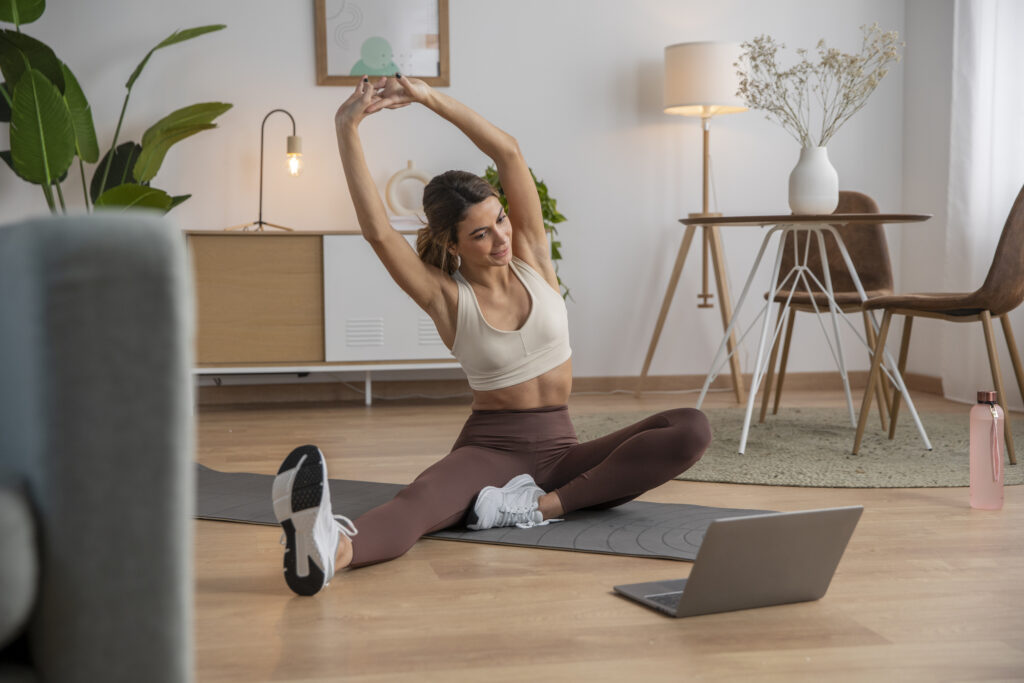You might underestimate how small adjustments in your daily life can profoundly impact your spinal health. For instance, setting up an ergonomic workstation or practicing mindful movements can enhance your posture and reduce strain markedly. Incorporating regular stretches and becoming aware of your body's alignment can also create lasting benefits. As you explore these authentic methods, you may find that understanding the nuances of spinal care opens up new possibilities for your overall well-being. What specific changes could you integrate into your routine to start experiencing these benefits?
Ergonomic Workstation Setup
Creating an ergonomic workstation setup is essential for maintaining spinal health, especially if you spend long hours at a desk. Your workspace should support your body's natural posture, reducing strain on your spine and muscles.
Start by adjusting your chair. It should provide adequate lumbar support and allow your feet to rest flat on the floor or on a footrest. Your knees should be at or slightly below hip level to enhance circulation and comfort.
Next, position your computer monitor at eye level. This prevents you from craning your neck or slouching, which can lead to discomfort and long-term issues. The top of the screen should be at or slightly below eye level, about an arm's length away from your face. If you use multiple monitors, arrange them to minimize neck twisting.
Your keyboard and mouse should be close enough that you can keep your elbows at a 90-degree angle, allowing your wrists to remain straight. This reduces the risk of repetitive strain injuries. Consider using wrist rests to further support your wrists while typing.
Lastly, make sure your workspace is well-lit to avoid straining your eyes. Natural light is ideal, but if that's not possible, adjust your lighting to reduce glare on your screen.
Mindful Movement Practices
While an ergonomic workstation setup lays the groundwork for good spinal health, incorporating mindful movement practices throughout your day can further enhance your well-being.
Mindful movement isn't just about exercise; it's about being aware of how you move your body and making conscious choices that support your spine.
Here are four mindful movement practices you can easily integrate into your daily routine:
- Take Breaks: Set a timer to remind yourself to stand up and move every hour. Use this time to stretch your legs, walk around, or simply change your position. This keeps your body from getting stiff and helps maintain good posture.
- Practice Deep Breathing: When you feel tension in your body, pause for a moment and take deep breaths. Inhale through your nose, allowing your belly to rise, and exhale through your mouth. This can help release tension and promote relaxation.
- Engage in Gentle Movements: Incorporate simple movements like shoulder rolls or neck stretches throughout your day. These small actions can alleviate tightness and improve your range of motion.
- Mindful Walking: Whether you're walking to your car or taking a stroll during lunch, pay attention to how your feet connect with the ground. Focus on your posture and the rhythm of your breath. This practice can ground you and enhance your body awareness.
Stretching and Flexibility Exercises
Stretching and flexibility exercises play an essential role in maintaining spinal health and overall mobility. By incorporating these exercises into your daily routine, you can greatly enhance your body's ability to move freely and reduce the risk of injury. When your muscles and ligaments are flexible, they support your spine better, allowing for proper alignment and function.
Start with simple stretches targeting your back, hips, and shoulders. For instance, try the cat-cow stretch to improve spinal flexibility and relieve tension. You'll alternate between arching your back and rounding it, promoting mobility in your spine.
Another effective stretch is the seated forward bend, which helps elongate the spine and stretch your hamstrings. Hold these positions for 15-30 seconds, breathing deeply to enhance relaxation and effectiveness.
Incorporating dynamic stretches, like torso twists, can also be beneficial. This exercise helps improve spinal rotation and flexibility. Simply stand with your feet shoulder-width apart, twist your torso to one side and then the other, keeping your hips stable.
Remember to listen to your body; stretching shouldn't cause pain. If you feel discomfort, ease out of the stretch. Consistency is key, so aim to stretch at least three times a week.
Over time, you'll notice improved flexibility, reduced muscle tension, and a greater range of motion, all contributing to better spinal health. By prioritizing these exercises, you're taking an important step towards a healthier, more mobile lifestyle.
Posture Awareness Techniques
Maintaining flexibility through regular stretching not only enhances your mobility but also sets the foundation for good posture.
Once you've established this flexibility, it's crucial to develop techniques that keep your posture in check during daily activities. Being aware of your posture throughout the day can greatly reduce strain on your spine and improve your overall health.
Here are some effective posture awareness techniques you can easily incorporate into your routine:
- Check Your Position: Regularly assess your sitting and standing posture. Confirm your shoulders are back, your spine is straight, and your head is aligned over your shoulders.
- Use Posture Reminders: Set reminders on your phone or use sticky notes placed around your workspace to remind you to sit or stand tall. Visual cues can help reinforce good habits.
- Engage Your Core: Strengthening your core muscles can help support your spine. When you're aware of your core engagement, you'll naturally maintain better posture.
- Practice Mindfulness: Spend a few minutes each day focusing on your body positioning. This mindfulness practice can enhance your body awareness and help you notice when you're slouching or misaligned.
Lifestyle Habits for Spinal Health
Adopting healthy lifestyle habits can greatly enhance your spinal health and overall well-being. One of the most effective ways to achieve this is through regular physical activity. Engaging in exercises that strengthen your core muscles not only supports your spine but also improves your posture. Activities like yoga, Pilates, and swimming are excellent choices that promote flexibility and balance.
Proper nutrition also plays a significant role in spinal health. A balanced diet rich in vitamins and minerals, particularly calcium and vitamin D, helps maintain bone density. Incorporate leafy greens, dairy products, and fish into your meals to make sure you're getting the nutrients needed for a strong spine.
Hydration is another essential factor. Drinking enough water keeps your spinal discs hydrated, which is important for shock absorption and overall spinal integrity. Aim for at least eight glasses of water a day, adjusting based on your activity level.
Additionally, managing stress through mindfulness practices can positively influence your spinal health. Stress can lead to muscle tension, which may adversely affect your posture and spinal alignment. Consider incorporating deep breathing exercises or meditation into your daily routine.
Finally, prioritize sleep quality. A good night's sleep allows your body to recover and repair itself, including your spine. Invest in a supportive mattress and pillow to make sure proper alignment while you sleep.
Conclusion
Incorporating authentic adjustments into your daily routine can make a significant difference in your spinal health. By setting up an ergonomic workstation, practicing mindful movements, and embracing flexibility exercises, you're actively investing in your well-being. Remember to stay aware of your posture and make small lifestyle changes that promote alignment. These simple yet effective habits not only prevent discomfort but also enhance your overall quality of life. Take charge of your spinal health today!

